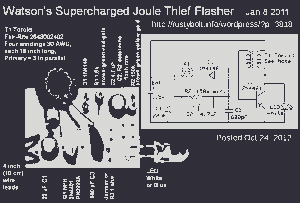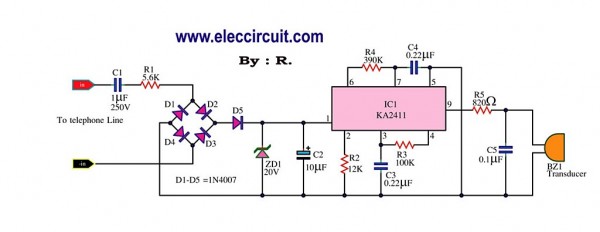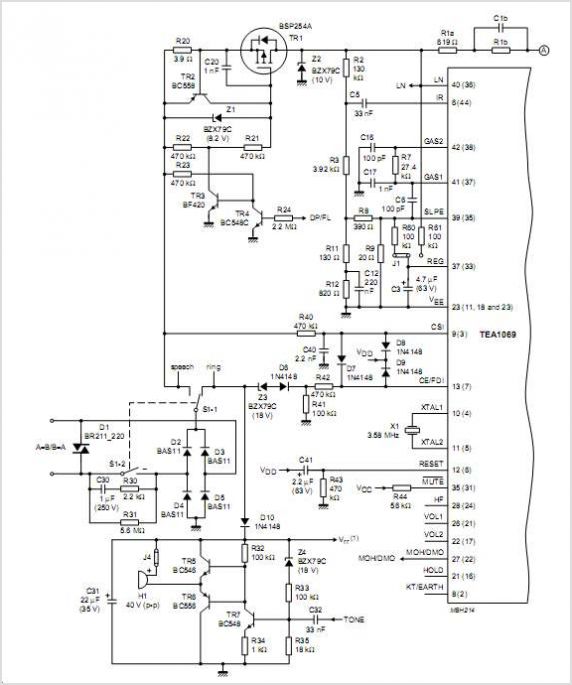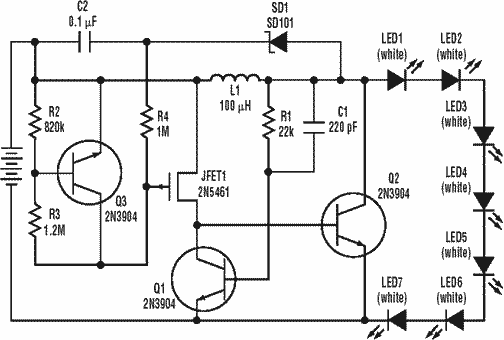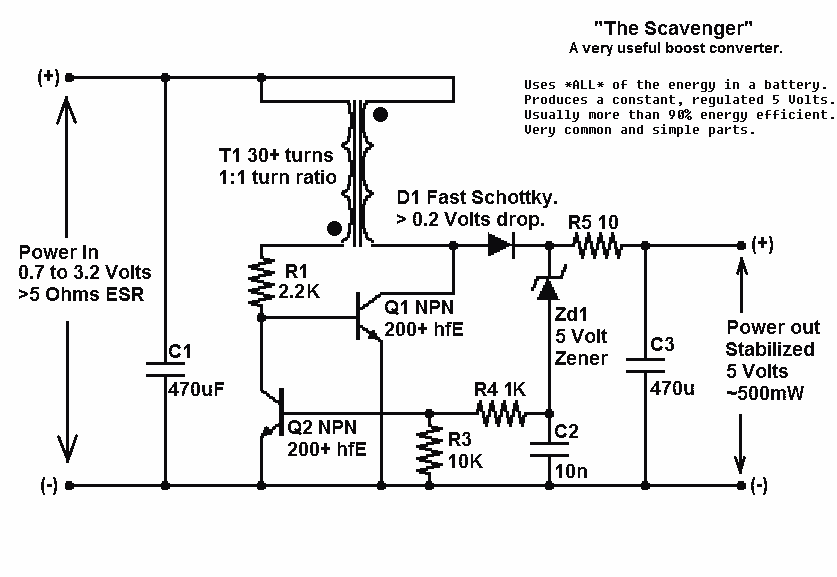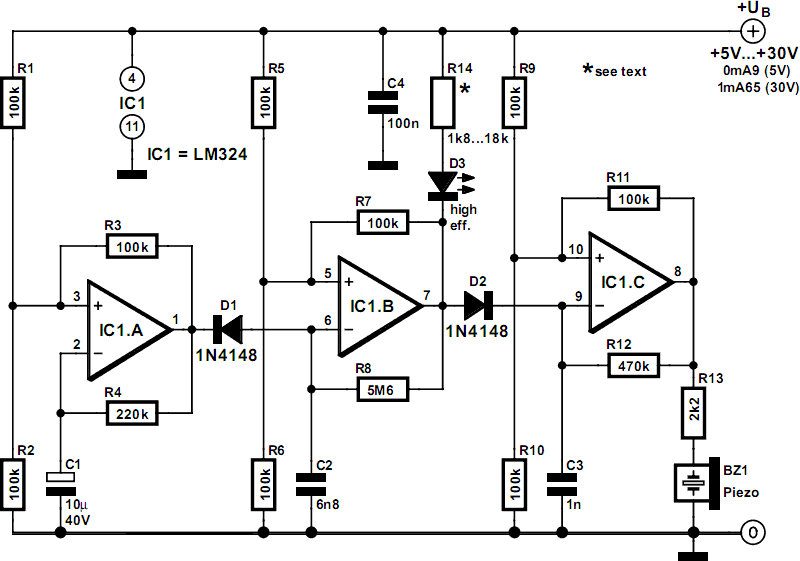
Joule Ringer 3
Warning: Undefined array key "extension" in /var/www/html/nextgr/view-circuit.php on line 468
Deprecated: strtolower(): Passing null to parameter #1 ($string) of type string is deprecated in /var/www/html/nextgr/view-circuit.php on line 468
A 14-watt equivalent light operates with only 1.2 watts of input. The brightness of the light increases as it approaches the watt rating of the CFL bulb. This circuit can power the CFL at low or high voltages. A dimmable CFL is typically challenging to achieve. For instance, when using a solar-charged battery that has been slightly discharged, the light will still illuminate, unlike with a standard 12/120-volt inverter. It is crucial to ensure that the transistor is correctly oriented and that all other connections are properly placed. Marking the connections around the transistor can help avoid mistakes that could damage the transistor or prevent the circuit from functioning. Once operational, observe the effects of hand proximity to the coil, both at the top and bottom. Holding an LED by one end will demonstrate where it lights up. Experimenting with AV plugs and LEDs or another CFL can be enjoyable. As long as the primary coil spans the entire length of the secondary coil, tuning is generally not an issue, although the number of turns in the primary may influence voltage versus current. It is noted that reverse biasing a transistor results in power being 2-3 times lower than the rated maximum, preventing damage at 12 volts. Observations indicate that a 2N2222 transistor, rated for 680 mA, operates at 200-225 mA. There is potential for paralleling two primary coils and transistors on a single secondary, although it is uncertain if synchronization will occur or if the bias voltage/current will be divided, affecting power output. The circuit is designed to self-adjust to load, suggesting that parallel transistors may equally share bias and potentially double the output power. There is uncertainty regarding the necessity of this setup. The DIY process has faced challenges, including unsatisfactory wire choices for L1 and plans to acquire better wire. Previous attempts with a 13-watt gutted CFL achieved partial illumination, indicating the need for adjustments to the primary-transistor combination or a smaller coil with fewer turns. Overloading LEDs connected to the secondary output caused some to fail, while unwinding layers of 30 AWG wire successfully powered 21 LEDs in series. Prior use of an 18-gauge wire secondary resulted in excessive heating of the TIP42C transistor due to its resistance. The current setup utilizes a wall transformer rated at 9 volts and 400 milliamps, which provides approximately 11.7 volts with no load, effectively powering the LEDs. This configuration is intended for continuous use as a bathroom or hallway light, with the ability to switch to a 12-volt battery as needed. A video demonstrating modifications to the "How to make the SJR2.0" project is available, showing that the basic Joule ringer can be enhanced with more turns, alternative transistors like the TIP2N3055, and magnet wire, while omitting the extra primary. The LEDs illuminate brightly with 9 volts and are exceptionally bright at 12 volts, suggesting that an 11:1 turns ratio may be necessary for optimal voltage.
The circuit described utilizes a compact design to achieve high efficiency in lighting applications. The 14-watt equivalent CFL bulb operates with minimal power input, demonstrating the effectiveness of the circuit in energy conservation. The use of a solar-charged battery provides versatility in energy sources, allowing for operation even under low charge conditions. Proper orientation and connection of the transistor are critical to prevent circuit failure, highlighting the importance of precision in electronic assembly.
The behavior of the circuit under varying loads is noteworthy; the self-adjusting nature allows for adaptability in different operational scenarios. The experimentation with coil configurations and the potential to parallel transistors indicates a progressive approach to optimizing performance. The findings regarding the reverse biasing of transistors reveal insights into power management, ensuring reliability at lower voltage levels.
The choice of wire gauge impacts thermal performance and efficiency, with the 30 AWG wire proving advantageous for LED applications. The results from the LED configurations suggest that series connections offer better performance compared to parallel setups, emphasizing the need for careful consideration of circuit design in achieving desired outcomes.
The integration of a wall transformer with a specific voltage rating offers a practical solution for powering the circuit, ensuring consistent performance for intended lighting applications. The option to switch to a 12-volt battery reinforces the circuit's versatility, making it suitable for various environments. Overall, the circuit represents a sophisticated blend of innovation and practical engineering, aimed at enhancing lighting solutions while minimizing energy consumption.14 watt equivalent light with just 1. 2 watts input. No, the light will be brighter and brighter as you approach the watt rating of the CFL bulb. What`s remarkable is that this circuit can light this CFL at very low voltage or higher too. A dimmable CFL is hard to do usually. Lets say you run a solar charged battery and the battery is run down a bit. The light will still come on. Try that with an ordinary 12/120 volt inverter! p. s. - take your time and really make sure the transistor is oriented correctly. and that all other wires are placed correctly. You may want to mark on some paper around the transistor what goes where. Its so easy to get something backwards and you`ll blow the transistor, or it wont work. Once you get it working notice the effect of your hand near the coil near the top vs bottom. Hold an LED by one end and notice where it lights. Try some AV plugs with LED or another CFL. Fun, fun, fun ! As long as the primary goes end to end on the secondary I don`t notice any tuning at all, or much difference how many turns the primary is. That may affect volts vs amps though. Yes, volts x amps = watts Interesting thing about reverse biasing a transistor - power is 2-3 times less than rated max so you wont ever burn them up on 12 volts.
That is what I am seeing with my little 2N2222 which can handle 680 ma. I am seeing 200-225 ma. I don`t know if it is possible but I will try paralleling two primary coils, two transistors on the one secondary. I don`t know if they will synchronize or if the bias voltage/current will be split and result in the same power output anyway, but I have the room on the coil for another primary, and I can just plug in another transistor.
LaserSaber used two primaries on his Super Joule ringer and left one unconnected. LaserSaber also notes that the circuit self adjusts to load so maybe the transistors in parallel will both be biased equally and double power output for more load. Or maybe this is totally unnecessary. I very much look forward to the DIY. I had very little time last night to rework my replication, but what I tried did not work. Not happy with the wire I am using for L1, and will go purchase some new wire. My local home improvement stores only carry 20 guage bell wire and RS has 22 guage hook-up wire. Any preference on these two choices. Please post the link to your DIY when completed. Hi folks, I have not had much luck yet either with lynxsteams air coil lamp, though I did get a 13 watt gutted cfl to light up partially, think I have to make some changes to my primary-transistor combo, or use a smaller coil tower, less turns.
Then I hooked 30 leds up to the secondary output and fried a few of the leds before disconnecting, way too much voltage for the leds in series, so I unwound many layers of 30 awg and it is brightly lighting 21 leds in series. Just to add, Before I wound the 30 gauge secondary, I used a 4 turn secondary of plastic insulated 18 gauge wire for powering leds in parallel and the resistance of that wire caused excessive heating of TIP42C transistor.
Though the 30 awg secondary powering leds in series seems to be the most efficient way to go, providing brighter leds for less input and less stress on the transistor. Right now, I am using a wall transformer, rated 9 volts, 400 milliamps, which gives around 11. 7 volts no load, which runs the leds pretty well, since I intend to use this as a bathroom light or hallway light, full time usage, with the idea in mind of quickly being able to switch to 12 volt battery if needed.
By request, here is a video of "How to make the SJR2. 0" I made some mods but followed the basic idea. You can see that you can "hotrod" the basic joule ringer with more turns, you can use a tip2N3055, use magnet wire, skip the extra primary. The LEDs light brightly off a 9 volt, or super bright off 12 volts. I think a 11:1 ratio is necessary to get the vol 🔗 External reference
The circuit described utilizes a compact design to achieve high efficiency in lighting applications. The 14-watt equivalent CFL bulb operates with minimal power input, demonstrating the effectiveness of the circuit in energy conservation. The use of a solar-charged battery provides versatility in energy sources, allowing for operation even under low charge conditions. Proper orientation and connection of the transistor are critical to prevent circuit failure, highlighting the importance of precision in electronic assembly.
The behavior of the circuit under varying loads is noteworthy; the self-adjusting nature allows for adaptability in different operational scenarios. The experimentation with coil configurations and the potential to parallel transistors indicates a progressive approach to optimizing performance. The findings regarding the reverse biasing of transistors reveal insights into power management, ensuring reliability at lower voltage levels.
The choice of wire gauge impacts thermal performance and efficiency, with the 30 AWG wire proving advantageous for LED applications. The results from the LED configurations suggest that series connections offer better performance compared to parallel setups, emphasizing the need for careful consideration of circuit design in achieving desired outcomes.
The integration of a wall transformer with a specific voltage rating offers a practical solution for powering the circuit, ensuring consistent performance for intended lighting applications. The option to switch to a 12-volt battery reinforces the circuit's versatility, making it suitable for various environments. Overall, the circuit represents a sophisticated blend of innovation and practical engineering, aimed at enhancing lighting solutions while minimizing energy consumption.14 watt equivalent light with just 1. 2 watts input. No, the light will be brighter and brighter as you approach the watt rating of the CFL bulb. What`s remarkable is that this circuit can light this CFL at very low voltage or higher too. A dimmable CFL is hard to do usually. Lets say you run a solar charged battery and the battery is run down a bit. The light will still come on. Try that with an ordinary 12/120 volt inverter! p. s. - take your time and really make sure the transistor is oriented correctly. and that all other wires are placed correctly. You may want to mark on some paper around the transistor what goes where. Its so easy to get something backwards and you`ll blow the transistor, or it wont work. Once you get it working notice the effect of your hand near the coil near the top vs bottom. Hold an LED by one end and notice where it lights. Try some AV plugs with LED or another CFL. Fun, fun, fun ! As long as the primary goes end to end on the secondary I don`t notice any tuning at all, or much difference how many turns the primary is. That may affect volts vs amps though. Yes, volts x amps = watts Interesting thing about reverse biasing a transistor - power is 2-3 times less than rated max so you wont ever burn them up on 12 volts.
That is what I am seeing with my little 2N2222 which can handle 680 ma. I am seeing 200-225 ma. I don`t know if it is possible but I will try paralleling two primary coils, two transistors on the one secondary. I don`t know if they will synchronize or if the bias voltage/current will be split and result in the same power output anyway, but I have the room on the coil for another primary, and I can just plug in another transistor.
LaserSaber used two primaries on his Super Joule ringer and left one unconnected. LaserSaber also notes that the circuit self adjusts to load so maybe the transistors in parallel will both be biased equally and double power output for more load. Or maybe this is totally unnecessary. I very much look forward to the DIY. I had very little time last night to rework my replication, but what I tried did not work. Not happy with the wire I am using for L1, and will go purchase some new wire. My local home improvement stores only carry 20 guage bell wire and RS has 22 guage hook-up wire. Any preference on these two choices. Please post the link to your DIY when completed. Hi folks, I have not had much luck yet either with lynxsteams air coil lamp, though I did get a 13 watt gutted cfl to light up partially, think I have to make some changes to my primary-transistor combo, or use a smaller coil tower, less turns.
Then I hooked 30 leds up to the secondary output and fried a few of the leds before disconnecting, way too much voltage for the leds in series, so I unwound many layers of 30 awg and it is brightly lighting 21 leds in series. Just to add, Before I wound the 30 gauge secondary, I used a 4 turn secondary of plastic insulated 18 gauge wire for powering leds in parallel and the resistance of that wire caused excessive heating of TIP42C transistor.
Though the 30 awg secondary powering leds in series seems to be the most efficient way to go, providing brighter leds for less input and less stress on the transistor. Right now, I am using a wall transformer, rated 9 volts, 400 milliamps, which gives around 11. 7 volts no load, which runs the leds pretty well, since I intend to use this as a bathroom light or hallway light, full time usage, with the idea in mind of quickly being able to switch to 12 volt battery if needed.
By request, here is a video of "How to make the SJR2. 0" I made some mods but followed the basic idea. You can see that you can "hotrod" the basic joule ringer with more turns, you can use a tip2N3055, use magnet wire, skip the extra primary. The LEDs light brightly off a 9 volt, or super bright off 12 volts. I think a 11:1 ratio is necessary to get the vol 🔗 External reference
